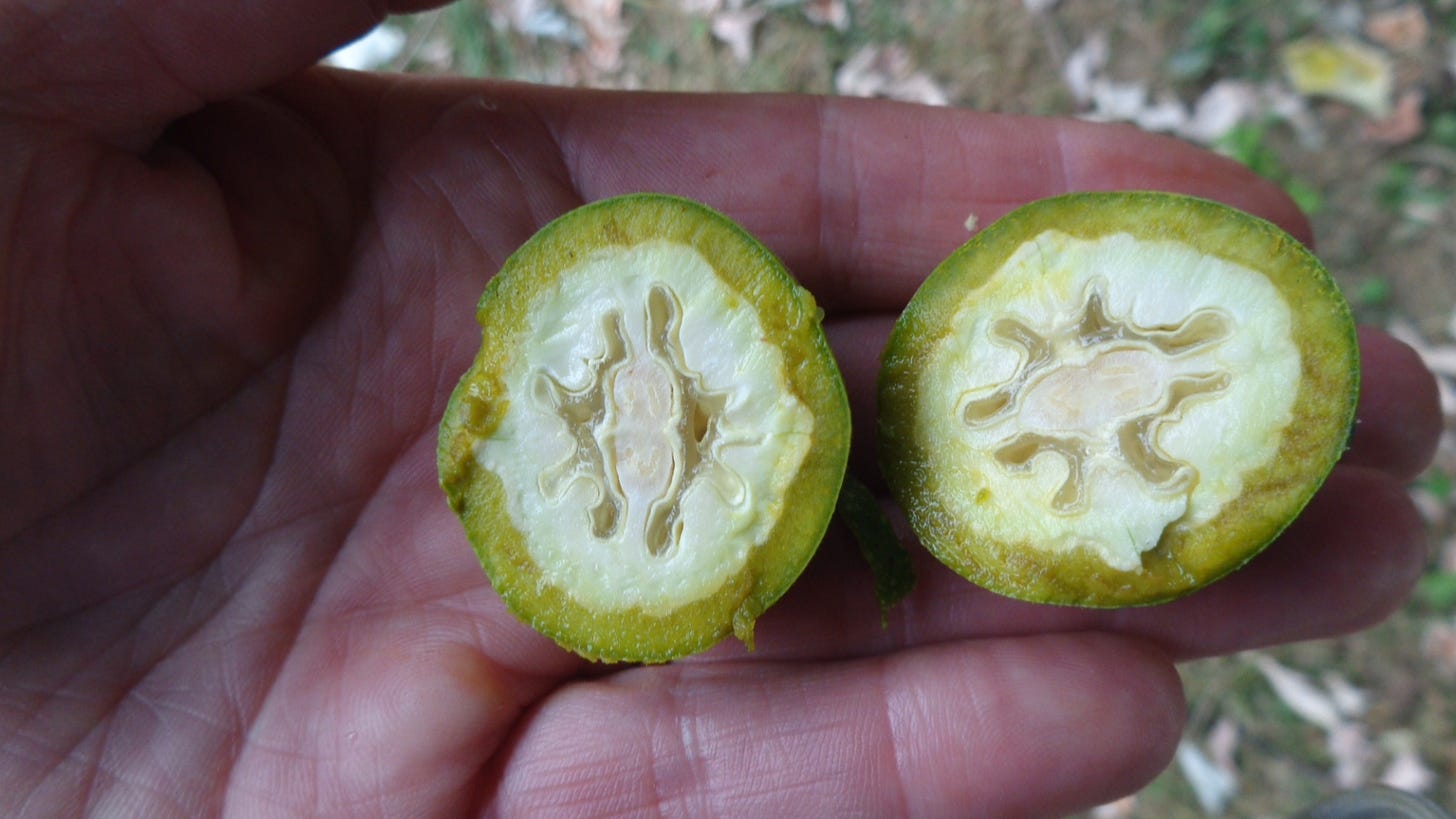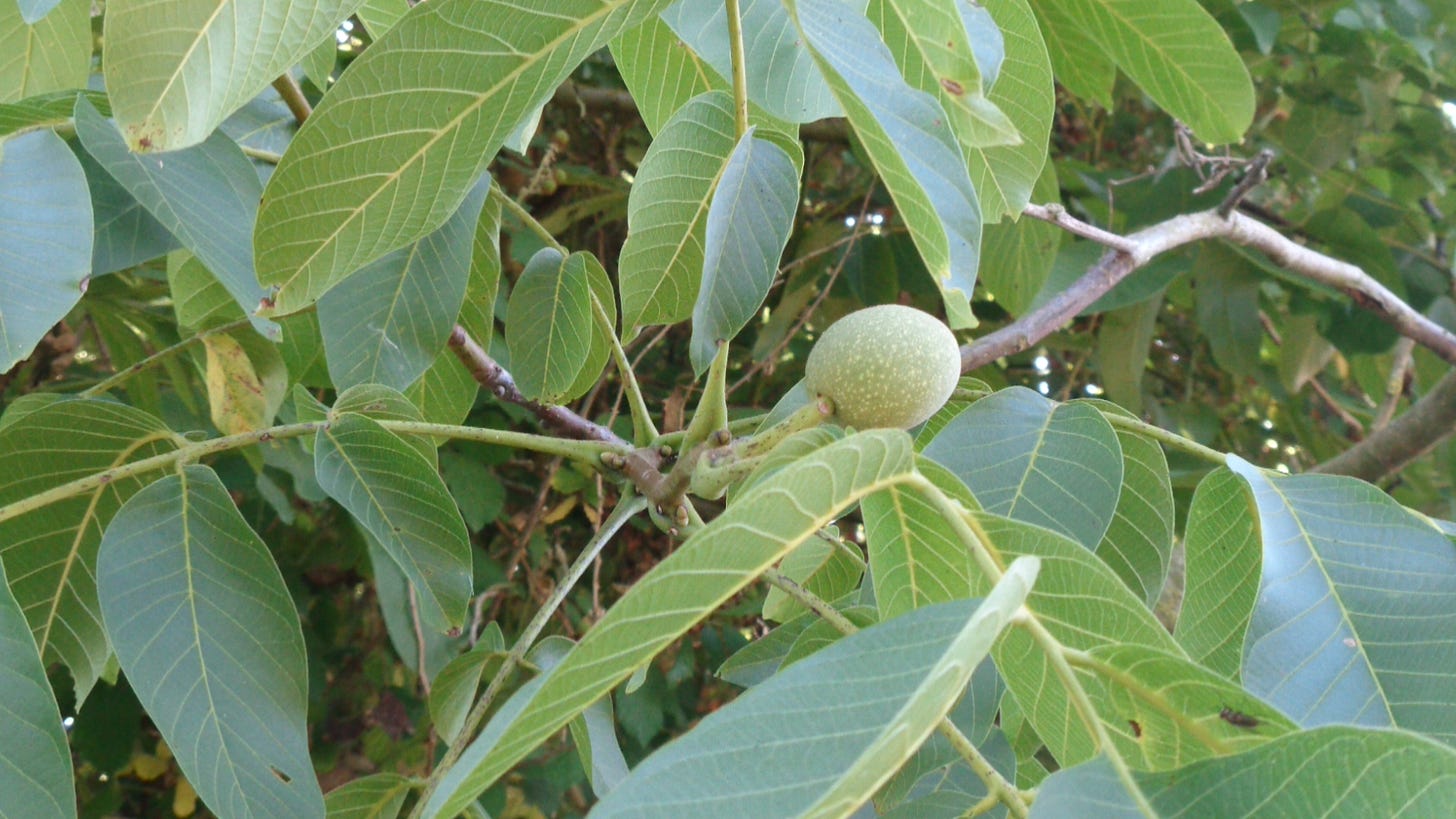What did the Romans ever do for us in the West? They introduced the walnut tree. This native of Asia and the Balkans has long escaped the villas where it was first cultivated and gone feral in suitably dry and sheltered places. Under the long, strongly-veined and shiny leaves -not unlike those of the rubber plant- the incipient nuts, lightly speckled lime-green globes, now hang in twos and threes. Identification is made certain by smell, which is that of disinfectant; the cause is the chemical juglone, a tanning agent used in hair and leather dyes. By the same token, handling the immature nuts causes black hand syndrome. You will suffer this if you pick green walnuts or ‘drupes’ for the French dish of pickled walnuts. Unless you wear rubber gloves. But rubber gloves out in the countryside, whether here in France or anywhere else …not a good look, as I can attest. Having picked the walnuts from the orchard yesterday I moved onto the great, shadowy walnut trees along the lane to the local town. The passing motorists were few, but their startlement as I reached upwards in marigold yellow washing-up gloves almost caused a succession of crashes.
By Gallic tradition green walnuts can be picked no later than 14 July, Bastille Day, but not before the feast day of Saint Jean, 24 June. Suitability is easy to determine: stick a pin in the green husk – if you if you can feel a shell inside, discard. Green walnuts for pickling require an unformed shell, and a white milky interior.
Recipe
Ingredients:
115g salt
1kg green walnuts
500ml malt vinegar
250g brown sugar
1 tsp allspice
1 tsp cloves
½ tsp cinnamon
1 tbsp fresh ginger, grated
Method: Dissolve the salt in the water to make a brine. Leave the nuts in the brine for seven days, then strain, drain and refresh the brine. Leave nuts submerged for another week. Drain, and dry on a rack for ten to twelve days. They will go black. Mix the remaining ingredients to make a spiced pickling vinegar.
Put the black walnuts in a kilner jar or similar, and cover with the spiced pickling vinegar. Seal.
And if you don’t fancy pickled walnuts, here is a recipe for the traditional aperitif of walnut country, vin de noix, sweet and dark, and which is obtained by macerating green walnuts in red wine and spirits, in my case cognac, from M. and Mme Trenet’s distillery in the nearby hamlet of Breuil.. In the past the walnut ‘wine’ was known for its therapeutic qualities and considered a medicinal tonic, digestive and depurative.
Recipe
Ingredients
3.5 litres red wine
1kg brown sugar
0.5 litre cognac
1 orange, cut into pieces
14 green walnuts, quartered
4 cloves
Mix all the ingredients in a big bowl, then place in a demijohn (bonbonne ). Shake every day for forty days. Sieve the liquid into sterilized bottles, and cork. Drink at Noël. Failing the above recipe, there is a venerable version based around the number four. To four litres of wine, add forty walnuts chopped into four, with forty cubes of sugar and a quarter of eau de vie (brandy), and mature for forty days.
Extract from LA VIE:A Year in Rural France, John Lewis-Stempel, Doubleday, 2023
10 July:. So today, after the dew had dried, I started on the lavender with the petrol hedge cutter. (A lavender harvest is no dainty tea- picking affair; ours is done with a Husqvarna 522HDR60X.) Despite the ditty’s claim ‘Lavender’s blue, dilly dilly’, lavender vraie is actually a washed- out mauve. Insects love the plant; almost every head was ornamented by a bee or a butterfly. (I left a tenth of every lavender bush uncut; a sort of tithe for Nature.) The petrol hedge cutter was brutally, loudly efficient; the perfume of the tumbling lavender towers was intoxicating. Like any harvest, that of lavender is a matter of just- right timing; when harvesting lavender for dried buds to use in pot pourri, sachets or culinary uses, one harvests when 25– 50 per cent of the buds are blooming. Like today. If I were harvesting lavender for essential oil distillation, I would wait until 50– 100 per cent of the buds are blooming. Lavender loses its oil to the heat of the day, so one harvests in the cool of the morning (before 10 a.m.) so the cut lavender has a higher oil content. After harvesting the thirty bushes, I laid out the stalks to dry on a 20m² tarpaulin as blue as the sky
.






